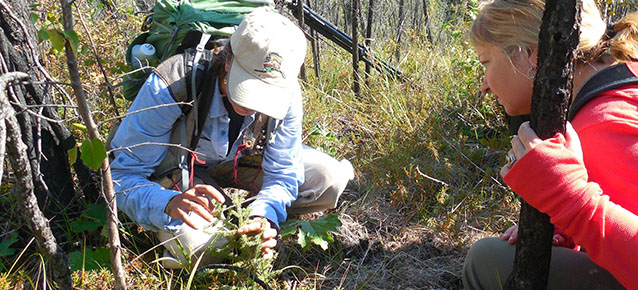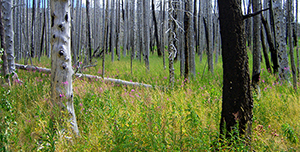From website updates to teacher workshops, the projects resulting from the inaugural Fire Communication and Education Grant Program (Fire CommEd Grant Program) in Fiscal Year 2015 will have impacts well beyond the end of the year.
Filling a Need

NPS
The Fire CommEd Grant Program provides funding to partially meet or supplement the needs of fire communication and education and fire interpretation in the parks and regions. The Fire Management Program Center Wildland Fire Budget Committee allocated $25,000.00 for the grant program and all the funds were awarded to fifteen projects in the Southeast, Intermountain, Pacific West, and Alaska regions of the National Park Service.
A Sampling of Projects Funded

NPS
- Yukon-Charley Rivers National Preserve: seven students enrolled in a July 2015 University of Alaska Fairbanks teacher professional development workshop to learn from and work with NPS Alaska Regional Fire Ecologist Jennifer Barnes during field and classroom sessions at Coal Creek Camp in Yukon-Charley Rivers National Preserve. In part, grant funds paid for Jennifer and a NPS photographer from the Fairbanks Alaska Public Lands Information Center to travel by NPS fleet aircraft from Fairbanks to Coal Creek Camp, affording an authentic and direct learning experience for workshop participants and providing an opportunity to capture video and still photo media of participants engaged in learning about fire ecology and management.
- Rocky Mountain National Park: provided workshop attendance to the Fire Ecology Institute for Educators in Florissant, Colorado for one employee who would then shadow, review, and provide feedback and new ideas for existing fire education programming at Rocky Mountain National Park. The workshop was very informative and provided fresh activities, updated content, and new ways to explain fire themes.
- Sequoia and Kings Canyon National Parks: updated the AM 1610 station sign to have one with lights that notified visitors that there was emergency information available by tuning their radio dial. This past summer, when it was first used, visitors were notified for events related to wildland fire or smoke hazards on roadways and in the parks.
- Glacier National Park: updated the fire information pages on the park website. The seasonal media specialist created pages for Wildland Fire, Current Fire Info, Outdoor Fire Safety, Fire Ecology, Fire History, Fire Education, and Fire Management. They can be viewed at https://www.nps.gov/glac/learn/nature/wildlandfire.htm.
- Everglades National Park: partnered with Education and Fire Management to conduct the PARK (Parks as Resources for Knowledge) Teachers program about “Fire in the Pine Rocklands” in November 2015 for two classes of pre-service teachers in the Science Methods course at Miami-Dade College. The grant provided each student participant with materials to replicate the program in their own future classrooms with students. Since the enrollment for the fall semester was only 38 students for two classes, the park will be able to use the remaining materials for the spring semester and future classes.
Value Added
Each of the grant recipients voiced their thanks at the value added provided by the grant and the opportunity to reach out and educate about wildfire, prevention, fire ecology, and more. Allyson Gantt of Everglades National Park stated, “Thank you for supporting this successful program and enabling us to provide participants with valuable follow-up materials to encourage them to teach their own students about the benefits of fire in our ecosystems.”
The NPS Branch of Fire Communication and Education hopes to continue on the success of this program and again award grants for fire interpretation and outreach in Fiscal Year 2016.
Tags
- big cypress national preserve
- everglades national park
- gates of the arctic national park & preserve
- glacier national park
- grand canyon national park
- hagerman fossil beds national monument
- pinnacles national park
- rocky mountain national park
- san juan island national historical park
- sequoia & kings canyon national parks
- wrangell - st elias national park & preserve
- yosemite national park
- yukon - charley rivers national preserve
- wildland fire
- maintain and restore resilient landscapes
- response to wildfire
- fire adapted communities
- communication
- go digital
- fire education
- fire
- cohesive strategy
- success stories
Last updated: November 30, 2017
